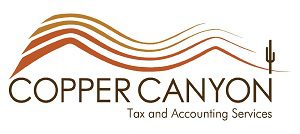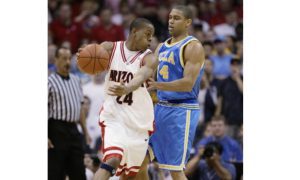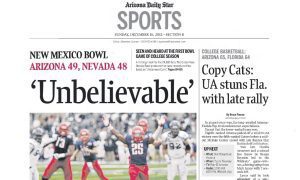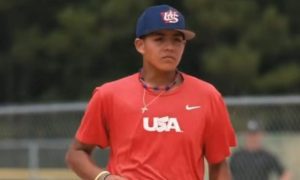|
|
|
ARIZONA PRODUCTIVITY RATING
[table “” not found /]
GLOSSARY:
G: Games played. S: Number of starts.
BP: Bench points. A player gets three points if he is first off the bench, two if second and one if third. Shows Sean Miller’s rotation.
COL: Productivity points against Colorado
CMIN: Minutes played against Colorado
PP: Productivity Points (Points, assists, rebounds, steals, blocked shots, FGs made, FTs made added together and then subtracted by missed FGs, missed FTs, personal fouls and turnovers)
TMIN: Minutes played overall
PR: Productivity rating per minute played (Productivity points divided by minutes played)
NOTE: Player must average at least 10 minutes a game to be listed in primary rotation
“It has everything to do with the respect I have for Arizona and Sean Miller and their basketball program. We beat a top 10 team in the country that’s legitimate and they’re going to win a lot of games as this season unfolds. And I think if we play the way we did tonight we will, too.”
Arizona (20-4 overall, 8-4 in the Pac-12) continued its trend of struggling on the front end of a weekend road series with its 71-58 loss to Colorado. The Wildcats’ primary eight-man rotation posted a season-low 60 productivity points (see glossary for productivity points) against the Buffaloes. The previous lows included a Thursday loss at Oregon (65 productivity points) and Thursday win at Washington (66 productivity points).
In the following games — at Oregon State and Washington State — the Wildcats responded with victories posting a season-high 116 productivity points against the Beavers and 93 against the Cougars. Oregon State and Washington State are in the bottom rung of the conference, as is Sunday’s opponent Utah.
One promising development was reserve forward Angelo Chol, the No. 9 player in the rotation this season, posting 14 productivity points in 20 minutes. Chol had the UA’s best productivity rating (.700). The only player who had more productivity points was Solomon Hill with 16, but Hill played 36 minutes to achieve that mark and finished with a .444 rating.
Chol, a sophomore, showed fundamental interior post moves reminiscent of Joseph Blair and Sean Rooks, one that resulted in an emphatic slam dunk in the first half. Chol was 4 of 6 from the field. Freshmen frontcourt starters Kaleb Tarczewski and Brandon Ashley struggled to get into the offensive flow taking only seven shots overall.
Arizona made a concerted effort to get the ball to Tarczewski, but he occasionally got trapped, bringing the ball low against defenders before going up. Ashley, like the entire team, found it difficult matching against Colorado’s speed and athleticism. In the two games against the Buffaloes, Ashley played 33 minutes and finished with a productivity total of minus-1.
“They’re a very fast team,” Hill was quoted as saying by the Associated Press. “When those guys get going they are one of the fastest teams in Pac-12 play. When they’re making shots they are probably the most deadly team in the Pac 12
“They are the best defensive team in the Pac 12, so they are a very deadly team, especially at home and if we don’t match their intensity, it’s going to be a long night.”
*****
Miller, acknowledging the quality of the opponent, was quoted as saying by the AP: “It’s never as bad as it seems and the sky isn’t falling.”
Arizona’s four losses are against teams — Oregon, UCLA, Cal and Colorado — that have a combined overall record of 70-28. The Wildcats’ NCAA resume still includes wins over Miami, Florida, San Diego State, Colorado and Southern Miss. Every Pac-12 team, including league-leader Oregon, would desire Arizona’s RPI (No. 9 entering Thursday’s game) and strength of schedule (No. 10).
While the sky is not falling, the same can’t be said of the production from some of Miller’s key players.
After the victory over Colorado in the first matchup, senior reserve Kevin Parrom led the UA with a .712 productivity rating. He is now fifth on the team with a .582 mark. Nick Johnson led the Wildcats with a .651 rating after the victory over Washington State on Feb. 2. In the three games since against Stanford, Cal and Colorado, he has managed only 28 productivity points in 99 minutes (a rating of only .283). His overall rating is down to .602.
Flu-like symptoms affected Johnson during the Washington State game and the following week. Now it appears Johnson just needs to get back in sync and play with a bounce again.
The Wildcats have time to make the necessary improvements against league coaches, who know that Arizona’s production on offense comes primarily from the shooting of Mark Lyons, Hill and Johnson. They combine for 30.3 field-goal attempts a game compared to only 9.5 by Tarczewski and Ashley.
Arizona’s NCAA title team of 1996-97 relied heavily on the scoring of perimeter players Mike Bibby, Miles Simon and Michael Dickerson but the Wildcats needed the athleticism of Bennett Davison around the basket primarily for putbacks off offensive rebounds and the interior scoring potential of A.J. Bramlett.
Davison and Bramlett were also more developed and experienced than Ashley and Tarczewski. Davison was in his first season after transferring from a junior college and Bramlett was a sophomore. Bramlett never had a season in which he shot less than 51.1 percent from the field. Tarczewski is shooting 49.1 percent, but only 40.7 percent in Pac-12 games.
In due time, Tarczewski will develop, perhaps becoming more of dominant go-to kind of player toward the end of next season. His best days are ahead. The same goes for Arizona and Miller.
*****
The Wildcats were out-rebounded for the fourth time in the last seven games, another area of concern for Miller. Colorado’s Andre Roberson, the Pac-12’s leading rebounder, pulled down 13 — almost more than Arizona’s entire starting frontcourt of Hill, Ashley and Tarczewski (which combined had 15).
Defensive Rebounding Percentage (DRB%): Determined by dividing Arizona’s defensive rebounds (19 against Colorado) by the opposition’s offensive rebounds (Colorado had only nine — it shot 59 percent in the second half) added to Arizona’s defensive rebounds (19) — 19/(9 + 19) = 67.9 percent.
Offensive Rebounding Percentage (ORB%): Determined by taking Arizona’s offensive rebound total (11) divided by that total (11) and the defensive rebounds of the opponent (22 for Colorado) — 11/(11 + 22) = 33.3 percent.
Ideal marks are 72 percent DRB% and 38 percent ORB%.
|
DEFENSIVE/OFFENSIVE REBOUNDING% [table “” not found /] |
Site publisher, writer and editor Javier Morales is a former Arizona Press Club award winner
[rps-paypal]
|
|

































